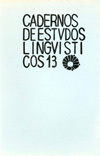Resumo
-Referências
ATLAS, J.D. e S. C. LEVINSON. (1981). It-chefts, informativeness, and logical form radical pragmatics (revised standard version). Em Cole (org). (1981). Pp. 1-62.
AUSTIN, J. L. (1962). How to do things with words. Oxford: Clarendon.
BAR-HILLEL, J. (1971). Out of the pragmatic wastebasket. Linguistic Inquiry. 2.4. pp. 401-407.
BENVENISTE, E. (1976). Problemas de Linguística Geral. São Paulo. Ed. Nacional.
GARDEN, G. (1976). English Quantifiers: Logical structure and linguistic variation. Nova Iorque. Academic Press.
CHAFE, W. (1971). Directionality and paraphrase. Language. 47. 1. Pp. 1-26.
CHOMSKY, N. (1965). Aspects of the theory of syntax. Cambridge, Mass.: MIT Press.
CHOMSKY, N. e M. Ronat. (1977). Language and responsibility. Nova Iorque. Pantheon Books.
COHEN, L. J. (1964). Do illocutionary forces exist? Philosophical quarterly, 14. Pp. 118-137.
COLE, P. (1978). On the origins of referential opacity. Em P. Cole (org). (1978). Syntax and semantics. Vol. 9 Pragmatics. Nova Iorque: Academic Press.
CRESSWELL, M. J. (1985). Structure meanings. Cambridge, Mass.: The MIT Press.
DAVIDSON, D. 91967). Truth and meaning. Synthese, 17. P. 304-323.
DUCROT, O. (1977). Princícios de semântica linguística: Dizer a não dizer. Trad. Por C. Vogt, R. Ilari e R. A. Figueira. São Paulo: Ed. Cultrix.
FODOR. G. 91970). Three reasons for not deriving kill from cause to die. Linguistic Inquiry. 1.4. pp. 429-438.
GAZDAR, G. (1979). Pragmatics: implicature, presupposition and logical form. Nova Iorque: Academic Press.
GAZDAR, G. (1980). Pragmatics and logical form. Journal of Pragmatics, 4. Pp. 1-13.
GIVÓN, T. (1979). On understanding grammar. Nova Iorque: Academic Press.
GIVÓN, T. (1982). Logic vs. pragmatics, with human language as the referee: toward and empirically viable epistemology. Journal of pragmatics, 6. Pp. 81-133.
GRAY, B. (1975). The same meaning with different forms. Language Sciences, 38. Pp. 1-8.
GREWENDORF, G. (1984). On the delimitation of semantics and pragmatics: the case of assertions. Journal of pragmatics, 8. Pp. 517-538.
GRICE, H. P. (1975). Logic and conversation. Em P. Cole e J. L. Morgan (orgs). (1975). Syntax and semantics vol. 3. Speech acts. Nova Iorque: Academic Press. Pp. 41-58.
HARMAN, G. 91970). Deep structure a logical form. Synthese 21. Pp 275-297.
HUTCHINSON, (1985). Nonlinguistic beliefs in linguistics. Journal of pragmatics, 9. Pp. 109-136.
ILARI, R. (1983). Dos problemas de imperfeita simetria. Ensaios de Linguística 9. Belo Horizonte: UFMG. Pp. 94-120.
KAC, M. (1972). Action and result: two aspects of predication in English. Em J. P. Kimball (org.) (1972). Syntax and Semantics vol. 1. Nova Iorque. Seminar Press. Pp. 117-124.
KATZ, J. J. 91980). Chomsky on meaning. Language.
KEMPSON, R. M. (1975). Presupposition and the delimitation of semantics. Cambridge: CUP.
KEMPSON, R. M. (1977). Semantic Theory. Cambridge; CUP.
LEECH, G. N. (1976). Metalanguage, pragmatics and performatives. Em C. Rameh (org. (1976). Semantics: Theory and application. Washington, D. C.: Georgetown Univ. Press.
LEVINSON, S. C. (1983). Pragmatics. Cambridge: CUP.
LYONS, J. (1968). An introduction to theoretical linguistics. Cambridge: CUP.
LYONS, J. (1977). Semantics. Vols. 1 e 2. Cambridge: CUP.
McCAWLEY, J. D. (1968). Lexical insertion in a transformational grammar without deep structure. Em papers from the fourth regional meeting of the Chicago linguistic society. Pp. 71-80.
McCAWLEY, J. D. (1971). Where do noun phrases come from? Em D. D. Steinberg e L. A. Jakobovits (orgs). (1971). Semantics. Cambridge: CUP.
RAJAGOPALAN, K. (1982). Negation and Denial. A study in the theory of speech acts. Tese de doutorado defendida na PUC-SP. Inédita.
RAJAGOPALAN, K. (1983). O caso dos verbos performativos no negativo: semântica ou pragmática? Tréplica Mary Kato.Série Estudos, 9. Uberaba FIUBE.
RAJAGOPALAN, K. (1984a). Ato ilocucionário de denegaçãocomo conceito chave na exploração de alguns problemas ligados à interação entre negação e quantificação. Anais do VIII Encontro Nacional de Linguística. Rio de Janeiro.
RAJAGOPALAN, K. (1984b). The Harris-Edmondson dispute: Identifying the strawmen. Journal of Linguistics, 20. Pp. 251-256.
RAJAGOPALAN, K. (1984c). Negação e denegação. VIII Anais do Seminário do GEL. Assis: Unesp.
RAJAGOPALAN, K. (1984d). Posso fazer uma pergunta? IX Anais de Seminários do GEL. Batatais: Faculdade José Olympio. Pp. 83-87.
REICHENBACH, H. (1947). Elements of Symbolic Logic. Nova Iorque. The Free Press.
ROSS, J. R. (1970). On declarative sentences. Em R. A. Jacobs and P. S. Rosenbaum (orgs). Readings in English Transformational Grammar. Waltham, Mas.: Ginn & Co. 222-272.
RUSSEL, B. (1905). On denoting. Em I. M. Copi e J. A. Goul (orgs).(1967). Contemporacy Readings in Logical Theory. Nova Iorque: The Macmillan Co. pp. 93-104.
SADOCK, J. M. (1974). Toward a Linguística Theory of Speech Acts. Nova Iorque: Academic Press.
SMITH, N. e D. WILSON (1979). Modern Linguistic: The Results of Chomsky’s Revolution Hammondsworth, Inglaterra: Penguim Books Ltd.
VOGT, C. (1977). O intervalo Semântico. São Paulo: Ed. Ática.
VOGT, C. (1980). Linguagem, pragmática e ideologia. São Paulo: Ed. Hucitec.
WILKINS, D. (1982. Dangerous dichotomies in applied linguistic. Em D. Crystal (org) Linguistic Controversies Londres: Edward Arnold. Pp. 221-231.
WILSON, D. (1975). Pressuppositions and Non-Truth-Conditional Semantics. Londres: Academic Press.
WITTGENSTEIN, L. (1921). Tractatus Logico-Philosophicus. Londres: Routledge & Kegan Paul.
O periódico Cadernos de Estudos Linguísticos utiliza a licença do Creative Commons (CC), preservando assim, a integridade dos artigos em ambiente de acesso aberto.

